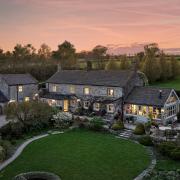Almondbury is one of Yorkshire’s oldest villages. Andrew Vine looks at five reasons to explore the history of this picturesque community close to Huddersfield
1 The people of Almondbury can trace their history back a very long way indeed, and the village’s heritage makes it one of Yorkshire’s most fascinating – and reason in itself to pay a visit. That history is bound up with the turbulence that followed the Norman Conquest, and the great survey of his new kingdom ordered by William the Conqueror that resulted in the Domesday Book. And it is in the book that Almondbury is first mentioned, the village two miles from Huddersfield being recorded as ‘Almondeberie’. It was in the ownership of the powerful De Lacy family, whose lands stretched from Clitheroe to Pontefract and who founded both Nostell and Kirkstall Priories.
The family’s name lives on in the village’s De Lacy Avenue, and in those far-off days when great swathes of Yorkshire were under their control, Almondbury was a far more important place than its close neighbour, Huddersfield.
Until the 17th century, Almondbury’s Monday market was the biggest for miles around, and its church stood at the centre of Christian activity in the area, its parish taking in the nearby villages of Linthwaite, Lockwood, Honley, Holmfirth and Meltham.
2 Castle Hill, overlooking Almondbury is one of the great Yorkshire landmarks, its hilltop folly built to mark Queen Victoria’s 60 years on the throne visible for miles around. Archaeologists believe that it was at least 4,000 years ago when humans first climbed the hill and began living in the forests that then covered its slopes. Iron Age man left his mark there with banks and ditches, but it was the De Lacy family who established a castle there by 1140.It became a place of leisure as the centuries passed, walkers heading for the top to take in the views. A bowling green was established, and there are records of prize-fights and rallies held there. The Victoria Tower was planned in 1897, and opened two years later. It cost £3,298 and was built by the firm of Ben Graham and Sons, of Folly Hall, using stone from Crosland Hill. The tower stands 106ft high, which means the top it is 1,000ft above sea level. It’s windy up there, and that has prompted another leisure pursuit on Castle Hill – kite flying, and to make that easier, overhead power cables were taken down and laid underground in 2006.
3 All Hallows Church is one of the finest in Yorkshire, certainly a place of worship for more than 900 years, even though nobody can be certain when it was built. Once again, the hand of the De Lacy family is evident, as they had a reputation as builders of churches. The West Yorkshire Archaeology Service believes All Hallows dates from the first half of the 12th century, and the original building was on the site of the present chancel. The church was added to as the centuries passed, with windows dating from the last 13th century and architectural features from the late 15th and early 16th centuries. The Victorians carried out further internal extensions and restorations. Then as now, All Hallows stands at the heart of Almondbury.
4 King James’s School is the very model of a modern, forward-looking comprehensive, being designated as a Specialist Science College in 2004 and an academy in 2012, but its roots lie deep in Almondbury’s history. There has been a school in Almondbury since 1547, and in 1608 it obtained a charter from James I, which went missing for many years until it was discovered in Leeds in 1952, and brought back to the school. And King James’s played its part in sporting history as well as the story of the village. Its headmaster from 1878 to 1895 was the Rev Francis Marshall, a passionate rugby fan, who was such a vocal opponent of the professionalisation of the game that his opponents met at the George Hotel, Huddersfield, to found the new code of Rugby League. Its famous old boys include runner Derek Ibbotson, actor Gorden Kaye, who played Rene in the hit comedy series ‘Allo, ‘Allo, and cricketer Ryan Sidebottom. One famous son of Huddersfield, though, was not bright enough to get in. Despite that, Harold Wilson went on to serve as Prime Minister. The Old Almondburians’ Society has some 800 members all over the world, and is believed to be the largest society of its kind outside privatte education. Every November, a dinner is held to mark the granting of the school’s charter, followed by a Founders Day service at All Hallows.
5 Wormald’s Hall is one of only six surviving Tudor buildings in Huddersfield. The Grade II listed building is Almondbury Conservative Club these days, and few political associations can have such distinctive homes. The building dates from the mid 1500s, but takes its name from owner Isaac Wormald, who had the ground floor clad in stone in 1631 to fit in with the style of the times. He left his mark on the building, in the form of the initials IWM carved over the door. Wormald’s Hall is an architectural gem, and widely considered the best example in West Yorkshire of its style of construction.



























